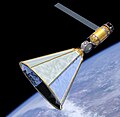A geosynchronous orbit (sometimes abbreviated GSO) is an Earth-centered orbit with an orbital period that matches Earth's rotation on its axis, 23 hours...
33 KB (3,226 words) - 04:30, 12 November 2024
A geostationary orbit, also referred to as a geosynchronous equatorial orbit (GEO), is a circular geosynchronous orbit 35,786 km (22,236 mi) in altitude...
49 KB (4,884 words) - 22:22, 31 December 2024
This is a list of satellites in geosynchronous orbit (GSO). These satellites are commonly used for communication purposes, such as radio and television...
67 KB (729 words) - 03:23, 7 December 2024
transfer orbit (GTO) or geosynchronous transfer orbit is a highly elliptical type of geocentric orbit, usually with a perigee as low as low Earth orbit (LEO)...
13 KB (1,801 words) - 19:57, 9 August 2024
graveyard orbit is a supersynchronous orbit well beyond geosynchronous orbit. Some satellites are moved into such orbits at the end of their operational life...
8 KB (1,009 words) - 01:04, 21 December 2024
Thus, a geostationary orbit is defined as a geosynchronous orbit at zero inclination. Geosynchronous (and geostationary) orbits have a semi-major axis...
31 KB (3,455 words) - 19:37, 27 October 2024
A geosynchronous satellite is a satellite in geosynchronous orbit, with an orbital period the same as the Earth's rotation period. Such a satellite returns...
9 KB (1,035 words) - 09:06, 28 July 2024
Space elevator (redirect from Geosynchronous orbital tether)
design's passenger climber would be able to reach the level of geosynchronous equatorial orbit (GEO) after an 8-day trip. Further details were published in...
89 KB (10,273 words) - 02:30, 3 January 2025
areosynchronous orbits (ASO) are the synchronous orbits for artificial satellites around the planet Mars. They are the martian equivalent of the geosynchronous orbits...
3 KB (374 words) - 15:25, 26 October 2024
have an inclined orbit around the Sun if it has an angle other than 0° to the ecliptic plane. A geosynchronous orbit is an inclined orbit with an altitude...
3 KB (338 words) - 20:20, 12 June 2024
but not all geosynchronous orbits are geostationary. A geostationary orbit stays exactly above the equator, whereas a geosynchronous orbit may swing north...
57 KB (8,123 words) - 10:15, 2 January 2025
200 mi) and that of the geosynchronous orbit at 35,786 km (22,236 mi). Geosynchronous orbit (GEO) Geocentric circular orbit with an altitude of 35,786 km...
17 KB (1,997 words) - 14:43, 5 September 2024
the boundary between MEO and HEO is the particular altitude of a geosynchronous orbit, in which a satellite takes 24 hours to circle the Earth, the same...
10 KB (1,037 words) - 23:27, 10 October 2024
A high Earth orbit is a geocentric orbit with an apogee farther than that of the geosynchronous orbit, which is 35,786 km (22,236 mi) away from Earth....
7 KB (602 words) - 22:39, 24 September 2024
than would be required from a geosynchronous orbit. Low Earth orbit A low Earth orbit (LEO) typically is a circular orbit about 160 to 2,000 kilometres...
50 KB (6,000 words) - 19:24, 3 January 2025
Altitude (section In satellite orbits)
200 mi) and that of the geosynchronous orbit at 35,786 km (22,236 mi). Geosynchronous orbit (GEO) Geocentric circular orbit with an altitude of 35,786 km...
26 KB (3,070 words) - 16:29, 11 October 2024
Orbital Sciences Corporation; their capabilities and development and construction budgets are classified. They operate in "near-geosynchronous orbit"...
5 KB (477 words) - 13:12, 25 September 2024
continuing past LEO, or satellites travelling at medium Earth orbit (MEO) or geosynchronous orbit (GEO). The catastrophic scenarios predict an increase in...
39 KB (4,433 words) - 13:57, 3 January 2025
Tundra orbit (Russian: орбита «Тундра») is a highly elliptical geosynchronous orbit with a high inclination (approximately 63.4°), an orbital period of...
18 KB (1,850 words) - 08:45, 18 December 2024
FYP and will be launched in the beginning of 13th FYP (2018–23) in geosynchronous orbit of 42° inclination. Also, the development of space-qualified Indian...
59 KB (4,907 words) - 05:36, 6 January 2025
Outer space (section Earth orbit)
concept used by the US to refer to space of high Earth orbits, ranging from beyond geosynchronous orbit (GEO) at approximately 35,786 km (22,236 mi), out to...
138 KB (13,620 words) - 06:10, 8 January 2025
Sun-synchronous frozen orbits. Orbital perturbation analysis (spacecraft) Analemma Geosynchronous orbit Geostationary orbit List of orbits Polar orbit World Geodetic...
14 KB (1,657 words) - 08:59, 12 December 2024
Space-based solar power (redirect from Orbital power satellite)
electricity. The program looked both at systems in Sun-synchronous orbit and geosynchronous orbit. Some of SERT's conclusions: The increasing global energy demand...
109 KB (12,551 words) - 08:03, 1 January 2025
Geosynchronous Satellite Launch Vehicle (GSLV) is a class of expendable launch systems operated by the Indian Space Research Organisation (ISRO). GSLV...
27 KB (1,999 words) - 10:52, 6 January 2025
Syncom (category Satellites in geosynchronous orbit)
lost on the way to geosynchronous orbit due to an electronics failure. Seconds after the apogee kick motor for circularizing the orbit was fired, the spacecraft...
22 KB (2,187 words) - 01:10, 9 December 2024
Starlink (redirect from Proliferated Low Earth Orbit program)
plans with the FCC to field a second orbital shell of more than 7,500 "V-band satellites in non-geosynchronous orbits to provide communications services"...
281 KB (23,831 words) - 11:18, 7 January 2025
Satellite Data System (section Orbital characteristics)
order to allow communications with polar stations that cannot contact geosynchronous satellites. The high apogee meant that the polar regions were visible...
12 KB (527 words) - 21:05, 22 November 2024
fueled Earth-to-orbit shuttle. A chemically fueled space tug to move crew and equipment between Earth orbits as high as geosynchronous orbit, which could...
10 KB (962 words) - 04:08, 21 November 2024
satellites that have nearly consumed their orbital maneuvering fuel and are likely placed in a geosynchronous orbit. The spacecraft would conduct a space rendezvous...
73 KB (7,951 words) - 09:18, 2 October 2024
NASA (section First orbital and hypersonic flights)
with satellites in low earth orbit (LEO), geosynchronous orbit (GEO), highly elliptical orbits (HEO), and lunar orbits. The NSN accumulates ground station...
223 KB (20,688 words) - 01:40, 8 January 2025





















